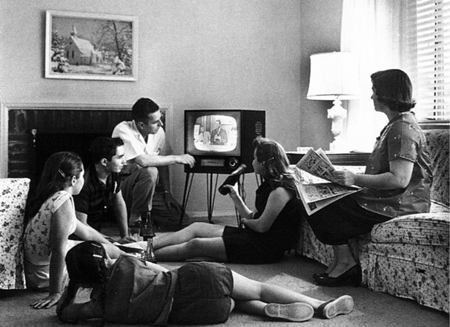The ghost of television past
At the 2019 Emmys on September 22, the four broadcast networks collectively had one show that won an award. On November 12, the Disney+ streaming service launches. These two milestones mark the end of television’s first era and the beginning of another. Center CEO Jeffrey Cole explains.
By Jeffrey Cole
The next 12 months will see the most important transformation in the entertainment industry–at least since the beginning of television in the late 1940s. We are six weeks from Disney firing the first and most important salvo in the coming television streaming war. November 12 will mark the launch of Disney+ at the Netflix-killing price of $6.99 per month. (I recently took advantage of a great promotion and bought a three-year subscription at $3.88 per month.)
 A year from now, after disruption and transformation, there will be new combatants in the streaming battle, while old ones will be injured or eliminated. When the smoke clears, we will see a different playing field in a changed industry.
A year from now, after disruption and transformation, there will be new combatants in the streaming battle, while old ones will be injured or eliminated. When the smoke clears, we will see a different playing field in a changed industry.
We are at the end of the first era of television. It should be celebrated.
Last month, on September 22, the larger world of television (broadcast, cable and streaming) rewarded its past year of excellence by handing out the Emmy Awards.
For most of the history of the Emmys, all of the awards went to the broadcast networks. The only battle that mattered was among ABC, NBC, and CBS (and later Fox) as to who earned bragging rights by winning the most awards. Occasionally, PBS or something independent would win an Emmy to prevent a broadcast network sweep. Shows like All in the Family, The Mary Tyler Moore Show, Hill Street Blues, Frasier, and miniseries like Roots and The Winds of War won buckets of awards.
Beginning around 2000, cable networks, especially HBO, began challenging the broadcast networks for the television movie and miniseries awards with programs like The Sopranos, Six Feet Under, and The Wire. By 2010, the broadcast networks were irrelevant in the Emmy categories of miniseries and made-for-television movies, but they still heavily dominated comedy and drama.
That 50-year run ended with the maturity of cable and the start of streaming. It’s not surprising that deep in Netflix’s $12 billion of original programming are some outstanding and Emmy-worthy series. (Although, in a recent column, I argued that HBO creates better programming and wins more Emmys with $2.5 billion worth of original programming than Netflix does with $12 billion).
That the broadcast networks have become irrelevant to every facet of programming was made brutally clear in the prime-time Emmy awards when ABC, CBS, NBC, and Fox had one show among all four that won an award. The four broadcasters would have been shut out but for a Variety Sketch Series Award and a Directing for Variety Series Award won by NBC’s Saturday Night Live.
Traditional cable also continued a steep decline in the number of awards compared to the rising monolith: streaming. If you consider HBO a streaming service (a controversial call since it is both a cable network and a streaming service—although moving strongly in the streaming direction), then cable fared only marginally better than broadcast.
Even if you declare HBO a cable channel with its many awards for Game of Thrones, Chernobyl, Last Week Tonight with John Oliver, and others, only Last Week Tonight will continue next year. Moreover, HBO’s future is clouded by the loss of much of its senior management, who left because they weren’t happy to work for the new owner, AT&T.
___________________________________________________________________________
A year from now, after disruption and transformation, there will be new combatants in the streaming battle, while old ones will be injured or eliminated. When the smoke clears, we will see a different playing field in a changed industry. We are at the end of the first era of television. It should be celebrated.
___________________________________________________________________________
It is better than even odds that last month’s Emmys also will signify the high point of success for HBO as it begins its transition from cable to streaming in the newly competitive world and from Time-Warner to AT&T.
Even the Emmys broadcast itself was bad news for the networks. Under a schedule created by the Academy of Television Arts & Sciences (ATAS), the Emmy Awards rotate among the four broadcast networks. This year was Fox’s turn.
The 2019 year’s ratings, which have been declining for more than a decade, were a debacle–dropping to 6.9 million viewers from last year’s 10.2 million (and that was a previous low point). The drop among the audience advertisers desire, 18-34, was even more dramatic.
Sadly, the broadcast networks are now overpaying for an awards show with rapidly declining ratings. They win almost nothing and the show only serves as a great promotional vehicle for streaming programs. Don’t expect to see the Emmys on broadcast television when the current broadcast contract ends.
The death of the “water cooler” moment
A handful of decades ago, the broadcast networks not only defined television, they also shaped our culture. In 1975, 90% of all television was in three places: ABC, CBS, and NBC. There is a long list of moments the whole country shared simultaneously (the birth of Little Ricky on I Love Lucy, the finale of M*A*S*H — watched by 106 million people out of a population of 235 million — and the answer to “Who Shot J.R.?” on Dallas).
Drama shaped our attitudes and our policy agendas through programs like Roots (slavery), The Burning Bed (spousal abuse), and The Day After (nuclear war).
In 2019, all of this cultural influence has shifted to streaming.
The difference is that the “water cooler” moment has disappeared. We don’t watch the same content at the same time and simultaneously share with each other. Streaming is designed to be watched individually and on our own schedules. The one noteworthy exception (and the only one so far) is the last episodes of Game of Thrones. Although those episodes can be watched at any time, most fans watched it as if it were live because of the fear social media would spoil the surprises and ending.
Our work at the Center shows that for those under the age of 30, only 15% of television is live: the other 85% is recorded or streamed. Of the 15% that is live, almost all of it is sports. The Super Bowl is about the only thing that can aggregate a massive television audience at the same time for the whole country to share.
And, we don’t think the Super Bowl will be on the broadcast networks much longer. Over two years ago, in one of my first columns, I argued the end of ABC, CBS, NBC and Fox in their current form will come when Amazon, Google, Facebook, and Microsoft decide to start bidding on sports rights. That same year, in a talk at CBS I pointed out, “Who is going to outbid the richest man in the world? Not you.”
The networks can barely afford the sports they currently run, and much of it runs at a loss. As the leagues demand more and more for the programming that guarantees an audience, the networks won’t be able to pay. Without sports, ABC, CBS, NBC, and Fox will collapse as linear, live networks and move to streaming. (Look at CBS All-Access as an example of what they will become). Last year, eight of the top 10 broadcast television shows were sports; seven of the eight were NFL Football.
Television is better than ever
The quality and quantity of excellent television has never been greater. We all suffer from “too much television” syndrome, which is the stress of deciding which of the great shows people tell us “we have to watch” we can find time to fit in our lives (after this month’s Emmys it was Fleabag).
Yet, the diminishing of broadcast television is sad to those of us over 40.
Television’s great executives from the 1980s like Brandon Tartikoff or Fred Silverman could have taught doctoral-level seminars on the strategy of television programming. They understood how you put a new show between two successful shows so that it could find an audience, and then later move it somewhere else on its own. They understood lead-ins and least-objectionable programming as if they were Nobel categories of science.
Today all of that thinking is meaningless and dead. There are no schedules except the ones we individually create.
Many of us watch shows such as The Tonight Show with Jimmy Fallon or The Late Show with Stephen Colbert on Facebook or YouTube, and we only watch the parts that interest us when we are ready. At 12:35 a.m., The Late Late Show with James Corden doesn’t get a lot of viewers. But his “Car Pool Karaoke” segment is available online, and that piece can get 2 billion viewers (as it did with Paul McCartney).
When I talk with millennials–describing my fond teenage memories of saying to my friends, “we can’t go out on Saturday until All in the Family and M*A*S*H are over at 9:00pm,” or “we can go out on Tuesday, but have to be home by 9:00pm for my favorite show”–I sound like a dinosaur. In the world of television, I am a dinosaur. My life changed when the VCR came along. That technology has already been dead for 15 years.
A new television era is about to begin. Of course, for anyone under 20, this is just the way they have always watched television. The new era brings new players, great content, and–for the viewer–complete control. In 10 years, the millennials will be the dinosaurs!
I would never go back. But as the new era begins on November 12, let’s pay our respects to the old era that’s ending.
____________

Jeffrey Cole is the founder and director of The Center for the Digital Future at USC Annenberg.
See all columns from the center.
October 2, 2019

